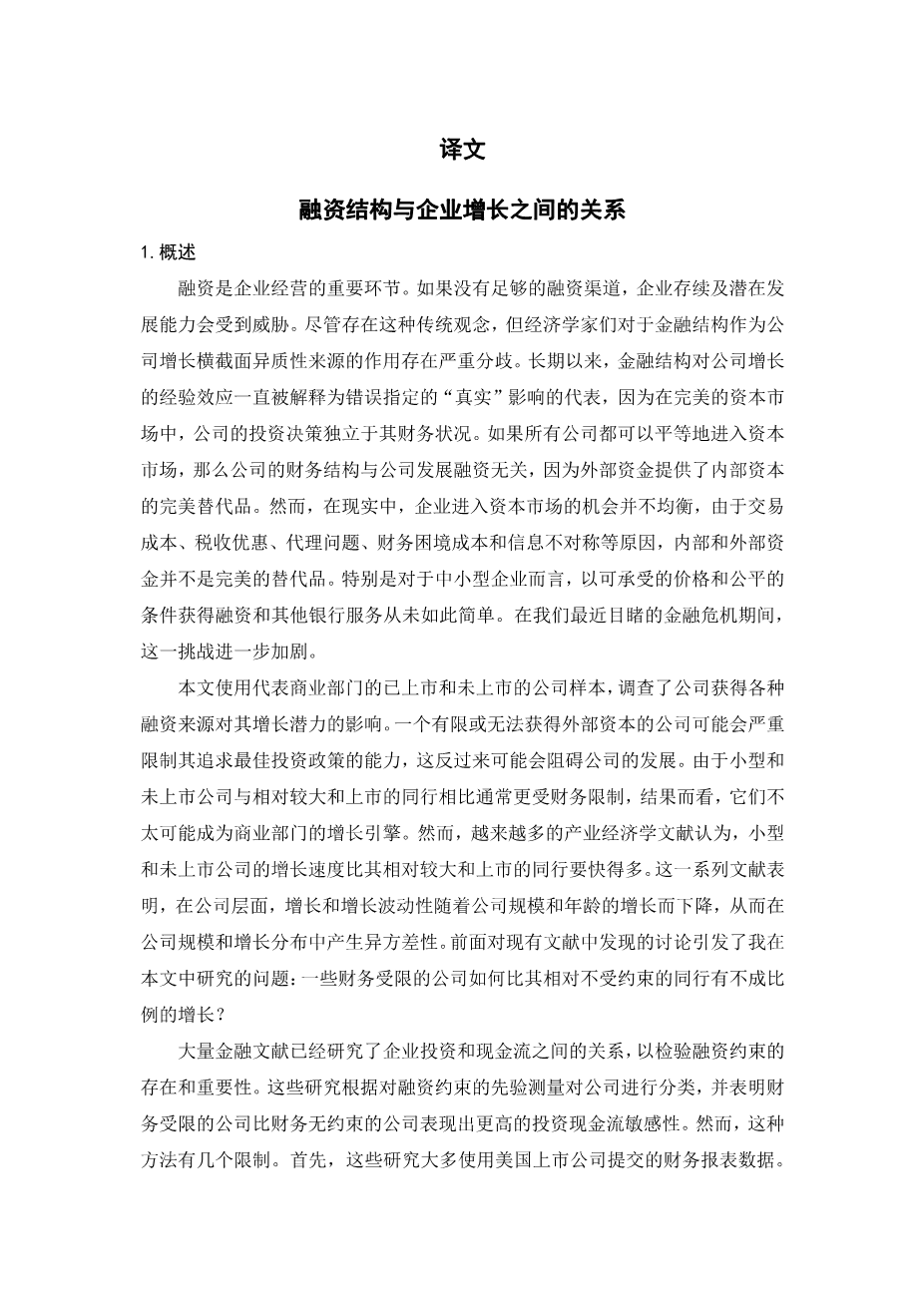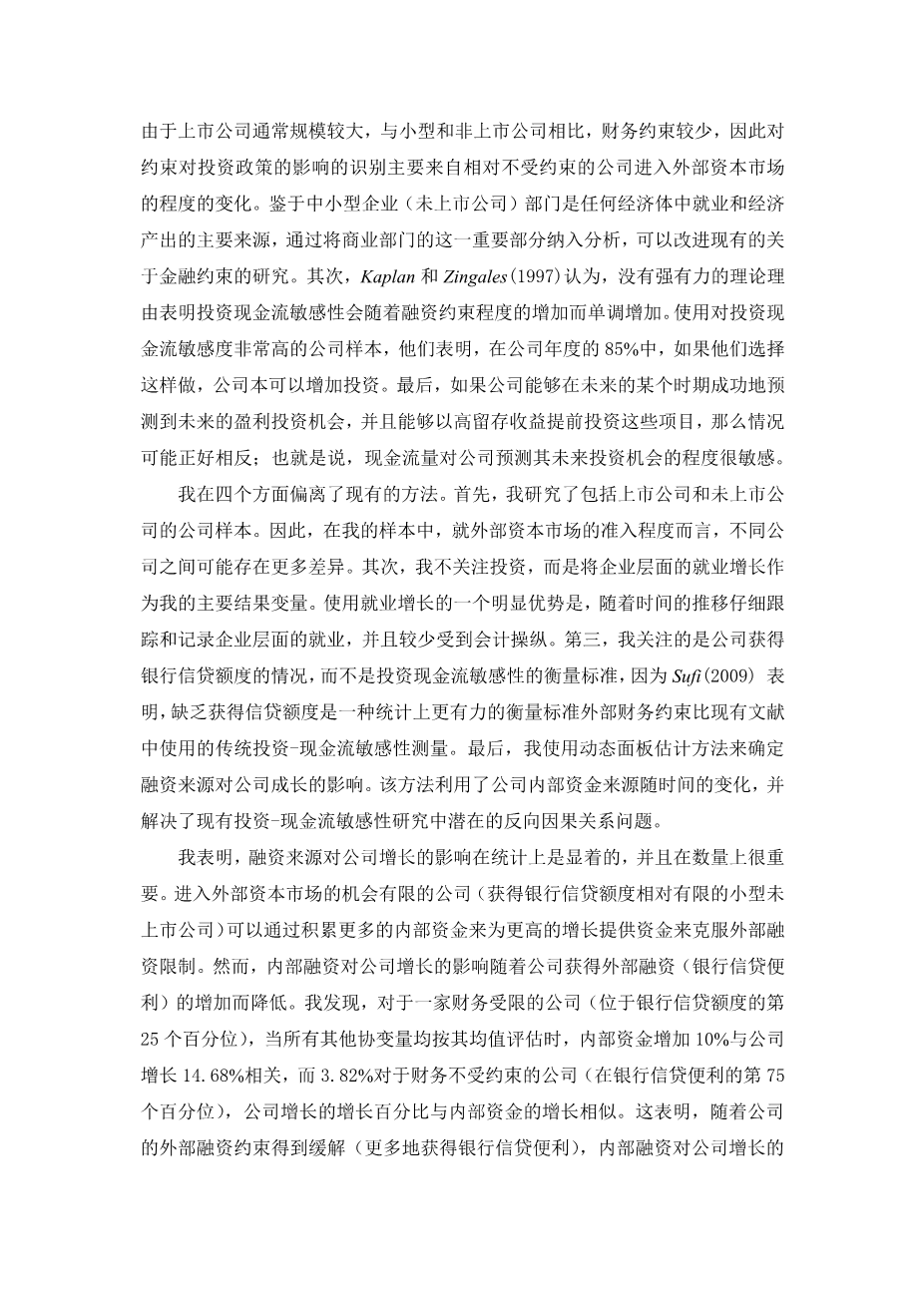外文原文
1. Introduction
Financing is an essential part of operating any businesses. Without adequate access to financing, the staying power of the business and its potential for growth is jeopardized. Despite this conventional wisdom, economists disagree sharply on the role of financial structure as a source of heterogeneity in the cross section of firm growth. The empirical effect of financial structure on firm growth has long been interpreted as proxies for misspecified lsquo;lsquo;real” influences because in a perfect capital market a firmrsquo;s investment decisions are independent of its financial condition. If all firms have equal access to capital markets, a firmrsquo;s financial structure is irrelevant in financing firm growth because external funds provide a perfect substitute for internal capital. In reality, however, firms have uneven access to capital markets, and internal and external funds are not perfect substitutes for reasons such as transaction costs, tax advantages, agency problems, costs of financial distress, and asymmetric information. In particular, for small and medium-sized businesses, obtaining financing and other banking services at affordable rates and fair terms has never been easy. This challenge is further exacerbated during financial crises like the one we witnessed recently.
In this paper, I investigate the effects of a firmrsquo;s access to various sources of financing on its potential for growth using a sample of quoted and unquoted firms representative of the business sector. A firm with limited or no access to external capital may be seriously constrained in its ability to pursue an optimal investment policy which, in turn, may hinder the firmrsquo;s growth. Since small and unquoted firms are generally more financially constrained compared to their relatively large and quoted counterparts, they are, in hindsight, less likely to be the engines of growth in the business sector. However, a growing literature in industrial economics argues that small and unquoted firms grow at a disproportionately faster rate than their relatively large and quoted counterparts. This strand of literature documents that, at the firm level, growth and volatility of growth decrease with firm size and age, generating heteroscedasticity in firm size and growth distribution. The foregoing discussion of the findings in the extant literature motivates the question that I study in this paper: How do some financially constrained firms grow disproportionately more than their relatively unconstrained counterparts?
A large finance literature already studies the relationship between corporate investment and cash flow to test for the presence and the importance of financing constraints. These studieclassify firms according to an a priori measure of financing constraints and show that financially constrained firms exhibit higher investment-cash-flow sensitivity than financially unconstrained firms. There are, however, several limitations to this approach. First, most of these studies use financial statement data filed by US public firms. Since publicly quoted firms are generally large and are less financially constrained compared to small and unquoted firms, the identification of the impact of constraints on investment policy comes mainly from the changes in the degree of access to external capital markets for relatively unconstrained firms. Given that the small and medium-sized enterprize (unquoted firms) sector is the major source for jobs and economic output in any economy, existing studies on financial constraints can be improved upon by incorporating this important part of the business sector into the analysis. Second, Kaplan and Zingales (1997) argue that there is no strong theoretical reason for investment-cash-flow sensitivities to increase monotonically with the degree of financing constraints. Using a sample of firms with very high investment-cash flow sensitivities, they show that in 85% of the firm-year, the firms could have increased their investment had they so chosen. Finally, if firms can successfully anticipate future profitable investment opportunities some periods ahead and can invest in those projects in advance with their high retained earnings, then the reverse might be true; that is, cash-flows are sensitive to how well firms can anticipate their future investment opportunities.
I deviate from the existing approach in four ways. First, I study a sample of firms that include both quoted and unquoted firms. Thus, in my sample, I potentially have more variations across firms in terms of their degree of access to the external capital markets. Second, instead of investment I focus on firm-level employment growth as my primary outcome variable. A clear advantage of using employment growth is that firm-level employment is carefully followed and recorded over time and is less subject to accounting manipulation. Third, I focus on a firmrsquo;s access to a bank credit facility as a measure of external financing constraints instead of investment-cash-flow sensitivity since Sufi (2009) shows that the lack of access to a line of credit is a more statistically powerful measure of external financial constraints than the traditional investment-cash-flow sensitivity measure used in the extant literature. Finally, I use a dynamic panel estimation method to identify the impact of financing sources on firm growth. This methodology exploits the variations in the sources of financing within a firm over time and also addresses the potential reverse causality problem in the existing studies on investment-cash-flow sensitivity.
I show that the effects of financing sources on firm growth is statistically significant and quantitatively important. Firms with limited access to external capital markets (small unquoted firms with relatively limited access to bank credit facilities) can overcome their external financing constraints by accumulating more internal
剩余内容已隐藏,支付完成后下载完整资料


英语译文共 13 页,剩余内容已隐藏,支付完成后下载完整资料
资料编号:[589250],资料为PDF文档或Word文档,PDF文档可免费转换为Word


